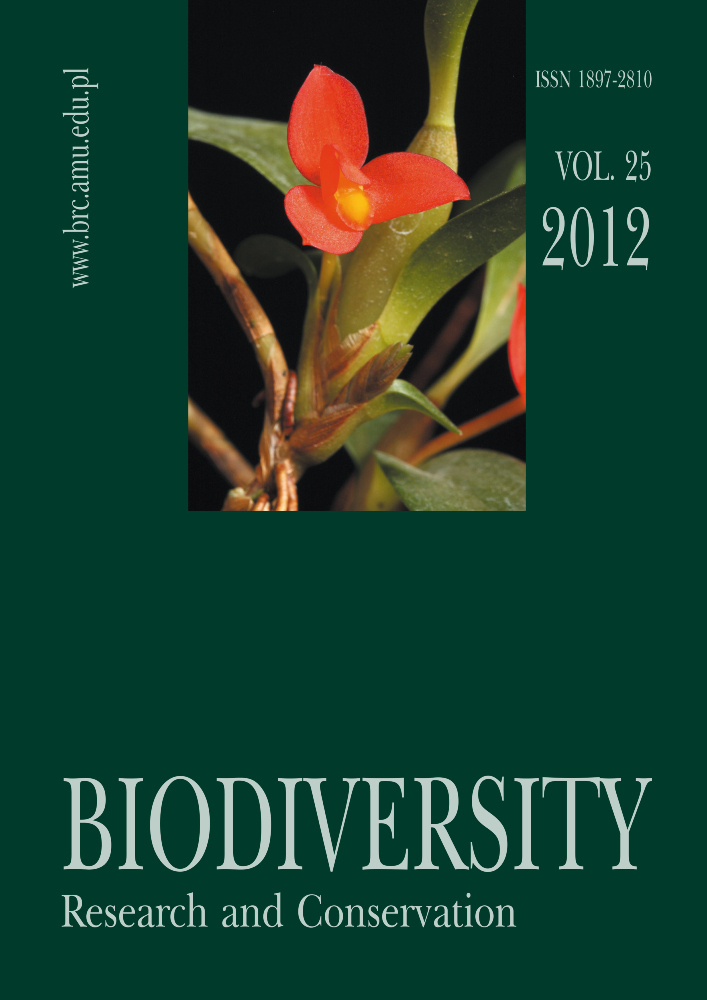Abstract
Arabis recta is one of the rarest species in Poland. It has been reported from 15 sites, mostly in the Nida Basin (Ma≥opolska Upland). The plant is a component of xerothermic grasslands but it can also grow in arable fields and fallows. In Poland, Arabis recta is considered to be threatened by natural succession and herbicide use. However, according to recent studies, it should be treated as an endangered species (EN category) in the country.
References
GRULICH V. 2012. Red List of vascular plants of the Czech Republic: 3rd edition. Preslia 84(3): 631-645.
FA£TYNOWICZ W. 2003. The lichens, lichenicolous and allied fungi of Poland. An annotated checklist. In: Z. MIREK (ed.). Biodiversity of Poland, 6, 435 pp. W. Szafer Institute of Botany, Polish Academy of Sciences, KrakUw.
KORNECK D., SCHNITTLER M. & VOLLMER I. 1996. Rote Liste der Farn- und Bl,tenpflanzen (Pteridophyta et Spermatophyta) Deutschlands. Schriftenreihe f,r Vegetationskunde 28: 21-187.
MATUSZKIEWICZ W. 2001. Przewodnik do oznaczania zbiorowisk roulinnych Polski. In: J. B. FALI-SKI (ed.). Vademecum Geobotanicum, 3, 537 pp. Wyd. Nauk. PWN, Warszawa.
MEDWECKA-KORNAa A., KORNAa J., PAW£OWSKI B. & ZARZYCKI K. 1972. Przeglπd waoniejszych zespo≥Uw roulinnych Polski. In: W. SZAFER & K. ZARZYCKI (eds.). Szata roulinna Polski, 1: 279-481. PWN, Warszawa.
MEUSEL H., JƒGER E. & WEINERT E. 1965. Vergleichende Chorologie der zentraleurop‰ischen Flora. I. Text 583 pp., Karten 258 pp. Gustav Fischer Verlag, Jena.
MIREK Z. & KAeMIERCZAKOWA R. 2001. Arabis recta Vill. n gIsiUwka uszkowata. In: R. KAeMIERCZAKOWA & K. ZARZYCKI (eds.). Polish Red Data Book of Plants. Pteridophytes and flowering plants, pp. 161-163. W. Szafer Institute of Botany, and Institute of Nature Conservation, Polish Academy of Sciences, KrakUw.
MIREK Z., PI KOa-MIREK H., ZAJĄC A. & ZAJĄC M. 2002. Flowering plants and pteridophytes of Poland. A checklistIn: Z. MIREK (ed.). Biodiversity of Poland, 1, 442 pp. W. Szafer Institute of Botany, Polish Academy of Sciences, KrakUw.
NOBIS M., KOZAK M. & BARTOSZEK W. 2007a. New data on the distribution of Arabis recta (Brassicaceae) in Poland. Pol. Bot. J. 52(2): 119-123.
NOBIS M., NOBIS A., KOZAK M. & PRZEMYSKI A. 2007b. Occurrence of Conringia orientalis (Brassicaceae) and Scandix pecten-veneris (Apiaceae) in the area of Nida Trough. Fragm. Flor. Geobot. Polonica 14(1): 49-59.
OCHYRA R., OARNOWIEC J. & BEDNAREK-OCHYRA H. 2003. Census catalogue of Polish mosses. In: Z. MIREK (ed.). Biodiversity of Poland, 3, 372 pp. W. Szafer Institute of Botany, Polish Academy of Sciences, KrakUw.
PAW£OWSKI B. 1977. Sk≥ad i budowa zbiorowisk roulinnych oraz metody ich badania. In: W. SZAFER & K. ZARZYCKI (eds.). Szata roulinna Polski 1: 237-269. PaOstwowe Wydawnictwo Naukowe, Warszawa.
TRZCI-SKA-TACIK H., TOWPASZ K. & DOSTATNY D. 1998. A station of the interesting xerothermic vegetation in Stawiany near PiOczow. ChroO. Przyr. Ojcz. 54(3): 87-90.
ZAJĄC A. 1978. Atlas of distribution of vascular plants in Poland (ATPOL). Taxon 27(5-6): 481-484.
ZAJĄC M. & ZAJĄC A. 2009. The geographical elements of native flora of Poland. 94 pp. Edited by Laboratory of Computer chorology, Institute of Botany, Jagiellonian University, KrakUw.




